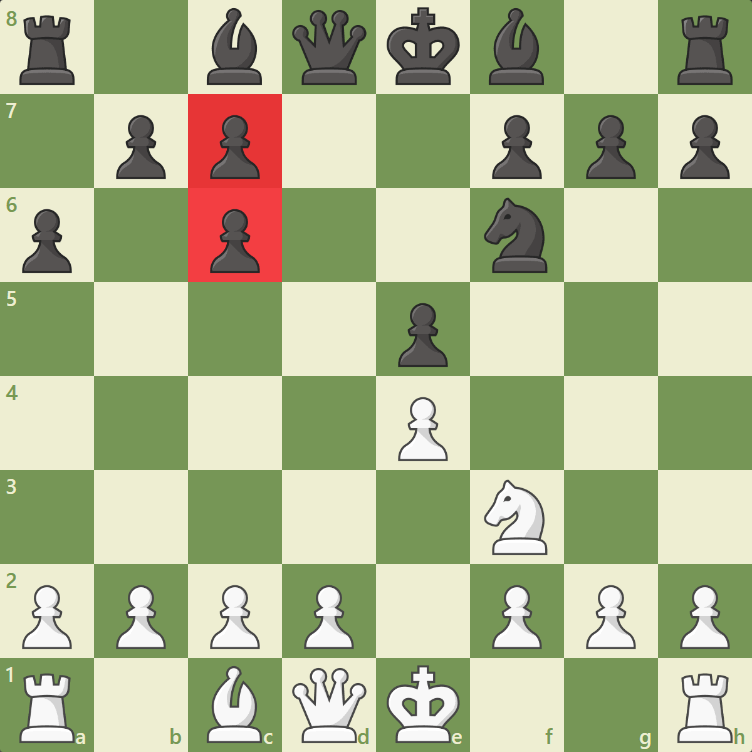Two pawns of the same color on the same line, often considered a weakness due to their limited mobility.

Introduction
Doubled pawns are a common structural feature in chess, occurring when two pawns of the same color are stacked on the same file after a capture. Traditionally seen as a weakness, doubled pawns can sometimes provide strategic advantages, depending on the position.
Are doubled pawns always bad? How have grandmasters used them effectively? And when should you avoid or embrace them? This article explores the pros and cons of doubled pawns, how they impact different phases of the game, and how to play with or against them.
1. What Are Doubled Pawns?
Doubled pawns occur when:
- One pawn captures on a file where a friendly pawn already exists.
- The pawns cannot advance together, limiting their mobility.
Example:
If White has pawns on c2 and c3, and then captures a piece with bxc3, White now has doubled pawns on the c-file.
2. Why Doubled Pawns Are Considered Weak
2.1 Lack of Mobility
Doubled pawns cannot support each other like normal pawn chains, making it harder to advance them.
2.2 Weakness in the Endgame
Doubled pawns can become targets because they lack the flexibility to create passed pawns.
2.3 Structural Weaknesses
Doubled pawns often create:
- Open files for the opponent (especially if an adjacent pawn is missing).
- Weak squares that cannot be defended by pawns.
✅ Example Weakness:
In the Isolated Queen’s Pawn (IQP) structure, the doubled pawns on the c-file create a long-term weakness that the opponent can exploit.
3. When Doubled Pawns Can Be Strong
3.1 Open Files for Rooks
Sometimes, doubled pawns open important files for rooks, allowing more active play.
✅ Example:
In the Ruy-Lopez Exchange Variation, White voluntarily accepts doubled pawns (c2 and c3) in exchange for:
- Control of the d4 square.
- An open b-file for rook activity.
3.2 Extra Central Control
Doubled pawns can control important central squares, restricting enemy piece movement.
✅ Example:
A doubled f-pawn can support a knight on e5, making it difficult for the opponent to challenge the center.
3.3 Defensive Solidity
Doubled pawns can sometimes reinforce key squares and create a solid defensive setup.
✅ Example:
In certain Caro-Kann structures, Black accepts doubled pawns in exchange for a strong kingside defense.
4. How to Play With Doubled Pawns
4.1 Trade or Undouble When Possible
Look for opportunities to exchange one of the doubled pawns or advance them to fix the structure.
4.2 Use the Open Files
If doubled pawns create an open file, place your rooks on it for counterplay.
4.3 Support the Stronger Pawn
If one of the doubled pawns is well-placed, use pieces to reinforce it rather than focusing on its weakness.
5. How to Play Against Doubled Pawns
5.1 Attack the Weaker Pawn
Doubled pawns cannot defend each other, making them natural targets.
5.2 Control Key Squares
If your opponent has doubled pawns, control the squares in front of them to limit their movement.
5.3 Force More Pawn Weaknesses
If the opponent has doubled pawns, create more weaknesses by forcing them to make more pawn moves.
6. Famous Games Featuring Doubled Pawns
Bobby Fischer vs. Boris Spassky (1972)
Fischer intentionally doubled his pawns to create an open file and better piece activity, demonstrating how doubled pawns can be a strategic weapon.
Garry Kasparov’s Attacking Play
Kasparov often accepted doubled pawns in exchange for dynamic play, proving that structural weaknesses can be outweighed by piece activity.
7. Conclusion
Doubled pawns are not always a weakness—they can provide open files, strong central control, or defensive solidity. Understanding when they are a liability and when they are an asset is key to improving positional play.
Key Takeaways:
- Doubled pawns are weak if they create open files for the opponent or become immobile.
- They can be strong if they control key squares or support active piece play.
- Strong players use doubled pawns to create long-term strategic advantages.
Mastering doubled pawns allows you to turn structural weaknesses into strengths and improve your overall chess strategy.

